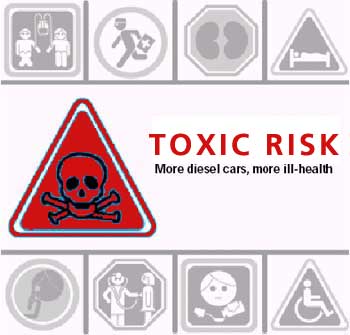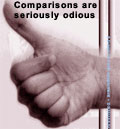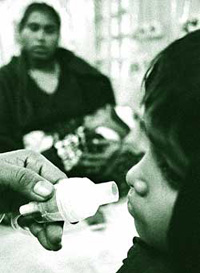|
 Diesel vehicles emit extremely carcinogenic particulates that significantly
damage our health. Diesel particles are coated with extremely toxic chemicals — about
40 known carcinogenic substances have been identified in diesel exhaust. In 1998, the
California Air Resources Board, USA, branded diesel particles as toxic air contaminants.
Subsequently, the US Environment Protection Agency (EPA) also accepted diesel particles as
carcinogens.
Diesel vehicles emit extremely carcinogenic particulates that significantly
damage our health. Diesel particles are coated with extremely toxic chemicals — about
40 known carcinogenic substances have been identified in diesel exhaust. In 1998, the
California Air Resources Board, USA, branded diesel particles as toxic air contaminants.
Subsequently, the US Environment Protection Agency (EPA) also accepted diesel particles as
carcinogens.
In its assessment of new emission regulations for heavy-duty diesel vehicles, slated to come into force in 2007, USEPA states that "the most compelling information that suggests a carcinogenic hazard is the consistent association observed between lung cancer and diesel exhaust exposure in occupationally exposed workers". EPAreviewing published literature, and found that about 30 different epidemiological studies showed an increased risk of lung cancer associated with diesel emissions. EPA evaluated 22 studies most relevant for risk assessment; 16 reported significant increase in lung cancer risks — 20 to 167 per cent — due to exposure to diesel exhaust.
The only study available on Indian cars, by Swedish consultancy Ecotraffic, shows that the cancer potency of diesel exhaust is more than twice that of petrol cars. If only particulate emissions are considered, the carcinogenic effect of one new diesel car is equivalent to 24 new petrol cars and 84 new CNG cars on the road. According to a study conducted by the German Federal Environment Agency, diesel is "several dozen" times more cancer-causing than petrol.
The problem: small particles that harmNearly all diesel particles fall into the fine particle size range (less than 2.5 microns); 50-90 per cent fall into the ultra-fine particle size range (less than 0.1 micron). Small size and large numbers offer greater surface area that allows toxic organic compounds to get adsorbed easily. In this way, diesel particles can go deep into the lower respiratory tract and, damaging lungs.
|
|||||
Studies have proved that diesel vehicles emit fine and ultra-fine particles in very large quantities. According to the California Air Resources Board, 94 per cent of the particle mass diesel vehicles emit is smaller than 2.5 microns. Another study in the UK found that 85 per cent of particles were less than a micron in size.
Particulate Air Pollution and Morbidity in the California Central Valley, 2002: Observed a strong and consistent increase in the rate of hospitalisation and/or emergency room visits for acute or chronic respiratory conditions associated with exposure to PM2.5. Every 10 per cent increase in the level of PM2.5 was associated with a 4.1 per cent increase in acute respiratory hospitalisations, a 7.5 per cent increase in chronic respiratory hospitalisations, a 5.2 per cent increase in acute respiratory emergency room visits and a 6.5 per cent increase in chronic respiratory emergency room visits. National Environmental Trust released a report in 2002: This calculates the cancer risk to children in the five most populated air basins in California. The report found that exposure to DPM will cause infants to reach the U.S. EPA’s one-in-one-million lifetime cancer limit in 17-32 days, depending on the air basin they live in. By the age of one, children will have exceeded this benchmark by 11 to 21 times, and by age 18, by 121 to 252 times. Adults reach the US EPA’s one-in one- million-lifetime cancer limit in 35-71 days from exposure to DPM. The California EPA’s cancer unit risk estimates were used in this study. US Public Interest Group (US PIRG) released a report in 2002: This estimates the lifetime excess cancer risk to the U.S. public from hazardous air pollutants. The report was based on population exposure levels from the EPA’s NATA report, and DPM toxicity estimates from the California EPA. The report concluded that throughout the U.S. the lifetime excess cancer risk from breathing hazardous air pollutants was 1 in 1,200, with DPM accounting for 89 per cent of this risk. Of the cancer risk from breathing DPM, 32 per cent is from emissions from on-road sources, and 68 per cent is from off-road sources. The World Health Organisation used four different studies: The studies were about the carcinogenic impact of diesel exhaust on rats. WHO used it to estimate unit risk values for cancer. Its conclusion was that the lifetime excess cancer risk ranged between 1.6 and 7.1 in 100,000 excess cancer cases per µg/m3 of DPM. This translates into one excess cancer case in a million from a lifetime diesel exhaust exposure of 0.014 to 0.0625 µg/m3 of DPM. Puget Sound Clean Air Agency released a draft report in 2002: This compared local air toxics monitoring data with data from the EPA’s NATA modeling estimates for the Puget Sound region. The Agency’s review confirmed the NATA modeling data and concluded that DPM accounted for 70-85 per cent of the total excess lifetime cancer risk from all air toxics in the region, with mobile sources of DPM contributing 85-95 per cent of the total risk. California’s South Coast Air Quality Management District released the results from their Multiple Air Toxics Exposure Study (MATES-II) in 1999: MATES-II was a comprehensive urban air toxics monitoring and evaluation study. Using the California EPA’s lifetime excess cancer unit risk estimate of 3 in 10,000 per µg/m3 of diesel particulate matter, the MATES-II study concluded that this was responsible for 70 per cent of the excess lifetime cancer risk resulting from air pollution in Los Angeles and the surrounding area, leading to an added average lifetime cancer risk of 980 in one million from exposure to diesel particulate matter.
As part of the Risk Reduction Plan to Reduce Particulate Matter Emissions from Diesel-Fueled Engines and Vehicles the California Air Resources Board compared the lifetime excess cancer risk from diesel particles with the cancer risk from the top ten air toxic risk contributors, using exposure information from its statewide air toxics monitoring network, and the California EPA’s cancer unit risk estimate. CARB’s conclusion was that exposure to air toxics in the state resulted in an average excess lifetime cancer risk of 758 in one million, and that diesel particles were responsible for more than 70 per cent of this added lifetime cancer risk. A study published by the US based Natural Resources Defence Council in January 2001: It points out that schoolchildren suffer from sustained exposures to diesel exhaust while travelling in school buses for 1-2 hours every day during a school year of 180-200 days over a schooling period of 10 years. It concludes that a child riding a diesel school bus is being exposed to as much as 46 times the cancer risk considered significant by the USEPA. |
|||||||||||||||||||||||||||||||||||||||||

